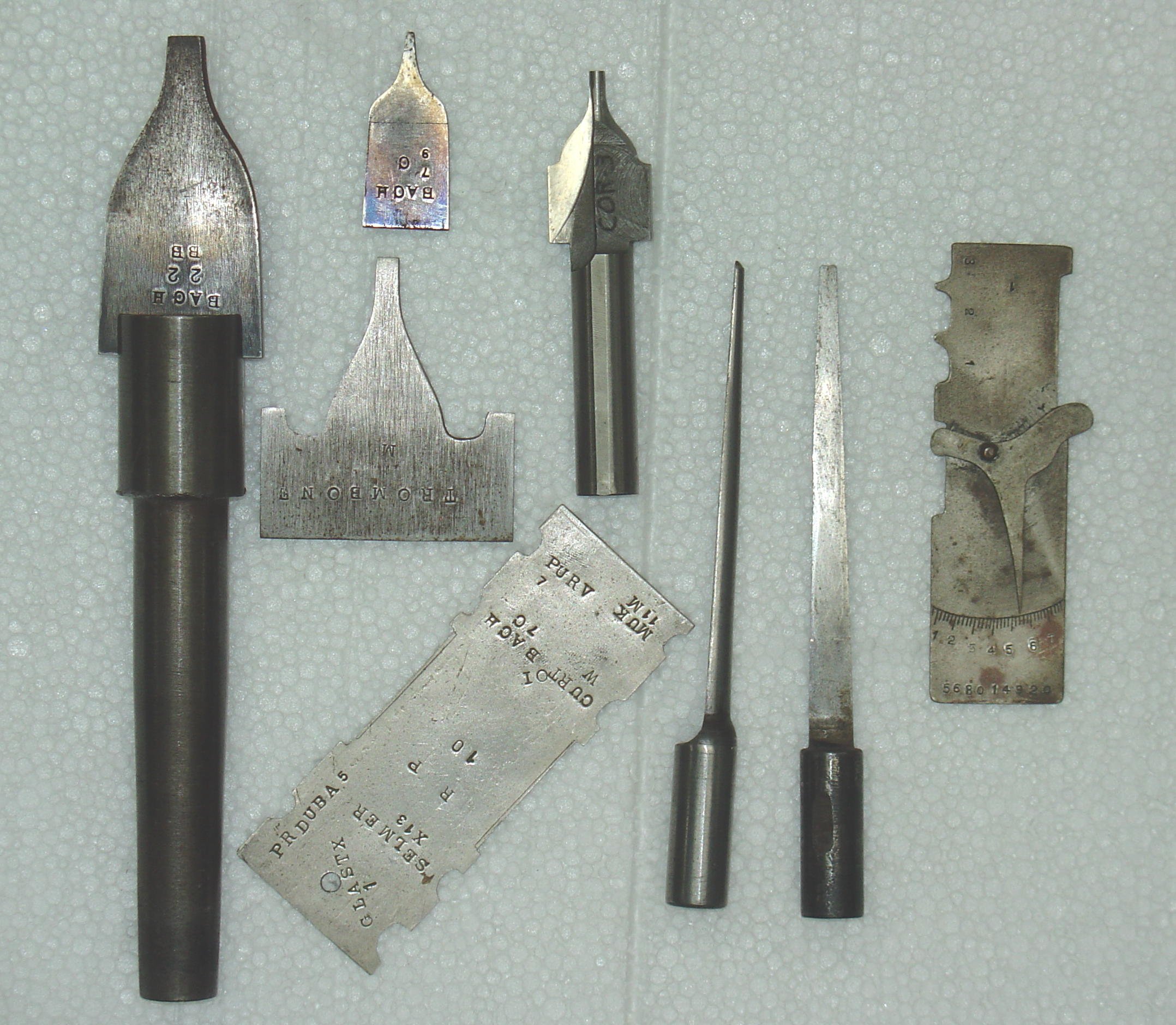Olds Trumpet Mouthpieces
Not being expert in the subject, I'm usually careful to avoid saying too much about mouthpieces other than identifying style, age and maker where possible. Most importantly, I try to identify mouthpieces that most likely came with the instrument in question when new. My years in this business, including making some mouthpieces, have taught me that mouthpieces are a specialty beyond what I do. That said, I wanted to share some of the early mouthpieces from F.E. Olds & Son that I have acquired. This is by no means a comprehensive representation, but shows changing styles and a few custom ordered examples. Most of these came to me randomly in boxes of mouthpieces or in instrument cases where they didn't originate. Just a few came to me with the instrument for which it was originally supplied.
A related collection is comprised of tools and a few mouthpieces that I purchased from Richard Plimpton, the son of Roe Plimpton. Roe Plimpton was a highly regarded professional trombone player and made custom mouthpieces for Olds from about 1930 until just before his death in 1963. I know that some of the tools were removed from the tool box before I acquired it, but it is still a good representation of what he used over the decades.
The first photo shows three trumpet mouthpieces made before about 1935 but not likely before the introduction of the Olds trumpets in 1928. These are stamped: “Olds 27”, “Olds” and “Olds OS”. The circa 1934 catalog shows both the funnel shape and bowl shapes made concurrently for different models. The middle example has an ivory rim and cup, which Olds had offered in trombone mouthpieces from at least 1925, although none of the known catalogs show this option for trumpet.
Olds trumpet mouthpieces from the early 1930s.
The second photo shows the new design that was introduced about the same time as the Super Olds trombones, about 1935, and used for all Olds production mouthpieces until the 1970s and are shown here in approximately chronological order. The mouthpiece on the far right is the one that was originally supplied with my 1948 Super Recording model trumpet.
Olds cornet and trumpet mouthpieces from about 1940.
The third photo shows two special order trumpet mouthpieces that I have identified as having been made by Roe Plimpton, using the blank cutter shown and the earlier using the letter stamps on the left. The "Olds" logo stamped on the mouthpiece on the far right was introduced in the mid-1950s and shows that Mr. Plimpton was still using this cutter on custom mouthpieces that late.
Two custom made trumpet mouthpieces by Roe Plimpton, cutting tool for exterior and “OLDS” stamps.
The fourth photo shows a small sampling of Roe Plimpton's tools. The three cutters in the upper left are all used in the tool holder seen in the lower left. There are about 60 of these in his tool box, mostly labeled as copies of other maker's mouthpieces and including trumpet, cornet, French horn, alto, trombone and tuba. The top middle cutter came from a different source and is the sort of tool that Olds used for cutting the cups in the 1970s. The nickel plate below that is a template used when hand cutting the rim shape. He had dozens of these in his tool box, each showing four to eight rim profiles and he obviously put great importance on the precise rim shape. The second and third tools from the right are backbore cutting tools of which there are several dozen in the collection, although most are duplicates made in the Olds toolroom. On the far right is a tool used for measuring the diameter of the cup. My understanding is that Roe Plimpton collaborated with the designer and fellow Olds employee, Peter Sekora, in designing this tool.
Array of Roe Plimpton’s mouthpiece making tools.
The last photo shows an array of Mendez model mouthpieces. Starting early in 1952 or before, Roe Plimpton worked with Raphael Mendez to develop these models. The first two are among the earliest and were probably made before the introduction of the Mendez model trumpet in 1952. They have no model number and the cornet has the Olds large shank. The third is stamped: "Mendez 2" indicating a shallow cup, the fourth: "Mendez 0" is another large shank cornet, the fifth: "Mendez 1" indicating a regular cup. The last is stamped: "Mendez Mendez" and is a prototype that was never finished.
Olds Mendez model mouthpieces in chronological order.





